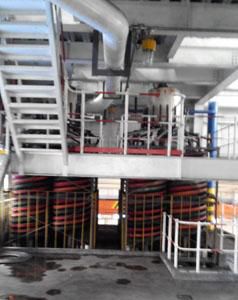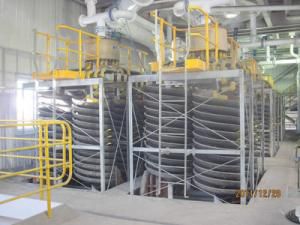When operating the shaking table, it is necessary to carefully observe the zoning of the shaking table surface and control the appropriate longitudinal and transverse slope of the bed surface. In addition, factors such as ore feeding particle size, ore feeding quantity, ore feeding concentration, flushing water, stroke and flushing times in the separation process need to be considered. The following is a brief description of the operation skills of the shaking table according to the above main factors.
1. Table surface zoning of shaking table
The bed surface is divided into concentrate area, medium ore area, tailings area and slime area. Under normal conditions, the width of slime area is 0.9 ~ 1.4m. The ore flow in the tailings area shall be stable without torrent or ditch, and the thickness of the ore bed shall be appropriate and covered by water. The tailings area can be controlled by adjusting the feed concentration and the sand hole of the feed tank. The medium ore area is the section where the medium ore is separated, which is mainly controlled by adjusting the flushing water and cross slope. The concentration area requires obvious zoning of various specific gravity minerals, so as to form a stable and obvious boundary between the concentration area and the primary concentration area, which is controlled by adjusting the flushing water and cross slope.
2. Transverse and longitudinal slope of shaker surface
During equipment installation, the longitudinal slope shall be determined. The coarse sand area has a longitudinal inclination of 1 ° ~ 2 °, the fine sand area has a longitudinal inclination of 0.5 ° ~ 1.0 °, and the slime area has basically no slope. The bed surface is inclined from the ore feeding end to the opposite side in the transverse direction of 1.5 ° ~ 5 °. During the actual operation of the shaker, it is necessary to accurately control the longitudinal and transverse slopes of the shaker surface. Generally, if the mineral particles are coarse, the cross slope of the shaking table surface should be appropriately increased. On the contrary, if the mineral particles are fine, it is necessary to lower the cross slope of the bed. Generally, the cross slope ranges of coarse sand area, fine sand area and slime area are 2.5 ° ~ 4.5 °, 1.5 ° ~ 3.5 ° and 1 ° ~ 2 ° respectively.
3. Feed particle size
The feeding particle size shall be appropriate. The upper limit of feed particle size is 2 ~ 3mm and the lower limit is 0.037mm. Generally, it is pre graded to ensure uniform particle size at all levels. In order to ensure uniform particle size at all levels of the shaking table and the feed particle size is within the appropriate range, it is necessary to observe the ore belt in the concentrate belt and the tailings after elutriation.
4. Ore feed
The size of ore feeding is related to the size of feed particle size. If the ore particle is coarser, the larger the ore feeding amount is required; However, if the ore feeding is too large, it will cause zoning problems. In this case, it is necessary to move the concentrate intercepting plate and increase the cross slope of flushing water and shaker bed surface. It should be noted that once the accurate feeding amount is found, the feeding process needs to be continuous and uniform.
5. Feed concentration
In the separation process, it is necessary to ensure the appropriate feed concentration. Generally, the feed concentration of coarse and fine minerals is 20% ~ 30% and 15% ~ 25% respectively. When there is a ditch problem on the table surface of the shaker, it can be adjusted by appropriately increasing the feed concentration; Conversely, if there is a sand pile, it is necessary to reduce the feed concentration. The feed concentration can be controlled by adjusting the feed water volume.
6. Flushing water
Flushing water includes ore feeding water and washing water. When operating the shaker, when the concentrate belt narrows and the concentrate runs into the middling, it is necessary to reduce the flushing water volume; On the contrary, if there is no water film exposed on the surface of the shaking table, it is necessary to appropriately increase the flushing water volume. When controlling the flushing water volume, carefully observe the pulp flow rate and the width of concentrate belt.
7. Stroke and stroke
The stroke and stroke times are mainly affected by the selected particle size of minerals, shaker load and ore density. When selecting coarse-grained and bed thick materials, large stroke and small punching times shall be used; On the contrary, small stroke and large stroke shall be used. In case of failure, it is necessary to check whether the stroke times of the beneficiation shaker are appropriate. If there is any abnormality, it needs to be adjusted in time.










